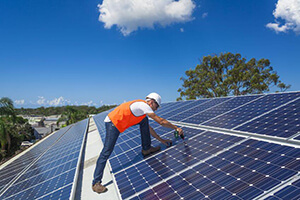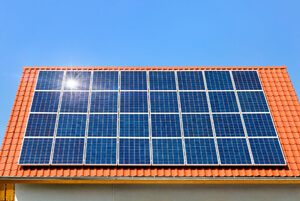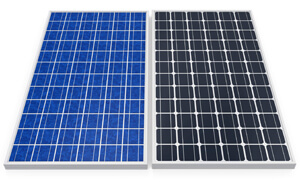What Are Solar Panels?
In the 21st century, it has become essential to switch to alternate sources of energy. Solar power has emerged as a great source of energy for household use, offices, etc. in Dunfermline
Solar panels, also referred to as photovoltaic (PV) panels, are the means by which light from the sun is converted. The light consists of energy particles known as “photons” that get converted into electricity.
A solar panel is made up of multiple solar cells. When several solar cells are spread across a large area, they can generate useable amounts of power.
The cells in PV panels are made of semi-conductive materials like silicon. They have both a positive layer and a negative layer, which create an electric field together.
How Do Solar Panels Work?
 When sunlight comes in contact with the semi-conductive material in the solar PV cell, the light energy gets absorbed
in the form of photons. It loosens up several electrons that then freely float around in the cell.
When sunlight comes in contact with the semi-conductive material in the solar PV cell, the light energy gets absorbed
in the form of photons. It loosens up several electrons that then freely float around in the cell.
Solar PV cells are carefully designed in a way that negatively and positively charged semi-conductors are squeezed together to form an electric field.
The field so formed compels the floating electrons to flow in a certain direction, specifically towards the conductive metal plates lining the cell. This flow is referred to as an energy current. The current's strength ascertains the amount of electricity each cell is capable of producing.
As soon as the free-floating electrons meet the metal plates, the current gets steered into wires, letting electrons move like they would in any source of electricity generation.
Understanding The Flow Of Current
When the solar panels generate electric current, the energy moves across a series of wires and into an inverter. However, solar panels create direct current (DC), while consumers typically require alternating current (AC) for buildings.
An inverter is used to convert DC electricity into AC electricity, making it more accessible for daily use.
Once the electricity is converted into AC power, it goes from the inverter into the breaker box (electrical panel) and is distributed across the building. This electricity can now be used to power electronics with solar energy.
What Happens To The Unused Electricity?
The amount of electricity that the breaker box doesn't consume is redirected to the utility grid via the utility meter.
The utility meter is a device that measures the flow of electricity between the grid and your property. If your solar energy system produces more electricity than you use, the meter runs backwards, and you receive credits for the excess through net metering.
Conversely, when you use more electricity than what your solar panel system generates, you pull electricity from the grid via the meter, and the meter runs normally.
What Are the Benefits of Solar Panels?
Despite its increasing popularity, there is not much awareness about the benefits of solar panels in Dunfermline.
Here are some of the major advantages of solar panels.
1. Decreases Air Pollution
Fossil fuels create a significant amount of pollutants, resulting in dirty air and smog. These pollutants are bad for our health and the environment. Moreover, with pollutants dispersed throughout the air, visibility decreases.
Solar panels use the sun's energy and create clean energy that doesn't create any pollution.
2. Decreases Dependence On Non-Renewable Sources Of Energy
Solar energy can help us reduce our dependence on non-renewable energy sources like fossil fuels. It is quite beneficial since these non-renewable resources result in pollutants that deteriorate air quality.
In addition, non-renewable sources are bound to deplete with time. However, renewable sources of energy will never run out.
3. Helps In Fighting Climate Change
 Traditional energy sources dump loads of pollutants in the air, along with additional carbon dioxide. It costs our
planet dearly as it becomes difficult for the ecosystem to clean the air.
Traditional energy sources dump loads of pollutants in the air, along with additional carbon dioxide. It costs our
planet dearly as it becomes difficult for the ecosystem to clean the air.
When carbon emissions go up, so does heat retention from the sun. It affects different climates in different ways, causing some areas to cool while others get warmer. As a result, weather patterns turn volatile across the globe.
After much research and experimentation, scientists and climatologists have determined that renewable energy projects are needed to control climate change.
When we use solar energy, we reduce our carbon dioxide emissions and do not release significant amounts of pollutants into the air.
4. Reduces Water Usage
If your current source of energy does not rely on fossil fuels, it most likely uses water to generate electricity. Nuclear energy and hydropower use huge amounts of water to produce electricity.
Sometimes, dams are built around water bodies to control how the water flows for producing electricity. However, this practice can negatively impact the local ecosystem.
Solar panels do not require any water and therefore protect the scarce resource.
5. Improves Health
Solar panels result in cleaner air, which is better for your lung health. Surprisingly, solar power also helps people have more food security in vulnerable regions.
The United Nations Development Program (UNDP) empowers women to run their own energy businesses via solar panels. It contributes to the income and directly assures food security for such people.
6. Reduces Electricity Bills
When you generate your own electricity with solar panels, you stop depending on your electricity grid. As a result, your utility bill goes down.
Solar panels can remain efficient for decades, which means you can make long-term savings on your electricity bills. In fact, some people go completely off the grid too.
7. Increases The Value Of The Home
Installing solar panels on your property makes the house more valuable. It happens because you are now independent of the electricity grid and produce clean energy.
Solar panels can be a little expensive, but the returns on your investment are completely worth it.
8. Low Maintenance Costs
With rapid technological advancements, the maintenance of solar panels has gotten much simpler and cheaper. Moreover, most panels come with warranties for a considerable amount of time.
You do not need to spend exorbitant amounts on the upkeep of your panels; regular cleaning is good enough.
What Is The Solar Panel Installation Process?
Once you've made up your mind to install solar panels in Dunfermline, gear up for the process that follows. There is a lot that needs to be done to ensure the proper installation of solar panels.
1. Find A Solar Panel Installer
Your Dunfermline solar panel installation journey begins with finding a suitable installer. The most important thing to remember here is that the installer should be MCS accredited so that you can be assured of the quality.
MCS is a certification by the Department of Energy and Climate Change (DECC). It ensures that green technology manufacturers and installers adhere to the highest possible standards.
You can look for MCS accredited companies via the MCS website.
2. Get A Quote
 You can ask for a quote either before or after deciding on a solar panel installer. The quote will detail the amount
of
time the entire project will take and how much it will cost.
You can ask for a quote either before or after deciding on a solar panel installer. The quote will detail the amount
of
time the entire project will take and how much it will cost.
Getting multiple quotes can help you make an informed decision.
3. Home Assessment
The installing company will send in a team with a qualified surveyor to carry out a proper assessment. They will also send a salesperson to present their various offerings.
After the assessment, do not get pressured in to signing a contract. Instead, look at the findings and try to understand the installer's assessment of your roof.
Once you've had enough time to look at the quotes and understand the assessment, pick an installer.
4. Set Up Scaffolding
The actual installation process begins with erecting scaffolding on your roof. It ensures safety for the workers on the roof throughout the duration of the installation.
5. Mount Installation
It is essential for the mounting to have a robust installation since they will finally support the solar panels. Mounts can either be roof-ground or flush mounts, based on your needs. The mounting structure ensures sturdiness and support.
The structure has to be slightly tilted since the panels are supposed to face specific directions. The angle of the tilt is typically between 18 to 36 degrees.
6. Install The Solar Panels
The PV panels need to be carefully placed in a particular direction. In the Northern Hemisphere, it is better for the panels to face South for maximum sunlight. However, facing East or West will also give good results.
For regions in the Southern Hemisphere, it would be better if the panels faced North.
The solar panels need to be fixed with the mounting structure using nuts and bolts for tightening. It has to be carried out very carefully to ensure that the structure is sturdy and lasts for a long time.
7. Electrical Wiring
The amperage, power, and voltage of a solar panel system determine how the panels are connected with the wiring. Typically, universal connectors such as MC4 are used for wiring since these connectors can be used with all kinds of solar panels.
The panels can be connected with each other in two ways:
Series Connection
In a series connection, the positive wire from one PV module is connected to the negative one of another. Such a wiring connection increases the voltage and matches it to the battery bank.
Parallel Connection
In a parallel connection, positive wires are connected to other positive wires, and negative wires are connected to other negative wires. The voltage of every panel remains the same in such wiring.
8. Connect To A Solar Inverter
For connecting the solar panel system to a solar inverter, the positive wire of the panel is connected to the positive terminal of the inverter, while the negative wire gets connected to the negative terminal.
9. Connect The Inverter To A Solar Battery & The Grid
In order to connect the solar inverter to the solar battery, the battery's positive terminal is connected with the inverter's positive terminal. Likewise, the negative terminals of both devices are connected to each other.
A solar battery is required for storing backup electricity in case you wish to go off-grid. However, it is also important to connect the inverter to the grid.
For this process, the installers use a normal plug to connect to the main power switchboard. Then, an output wire gets connected to the electric board that is responsible for supplying electricity to the house.
10. Start Solar Inverter
Once all the electrical wiring and connections are completed, you can start using your solar inverter immediately. Most inverters come with a digital display to show you the status of usage and generation of the solar unit.
How Long Does A Solar PV Installation in Dunfermline Take?
Before you decide on a provider, you can ask them for a quote and how long the entire process will take. The duration depends on the complexity and size of your solar panel system in Dunfermline.
It takes a few weeks to get quotes and home visits from installers. But once you decide on a provider, the process will not take much longer.
As soon as the scaffolding is complete, the actual installation should be done within a day in the case of regular sized panels. However, bigger panels might take a more prolonged period.
Are Solar Panels in Dunfermline Worth It?
To determine whether solar panels are worth it or not, you first need to understand that they are a long-term investment. Initially, it might be a little costly to install a solar panel system. However, the benefits will kick in gradually.
Yes, solar panels are worth it under certain conditions. If you generate a sufficient amount of energy and stay in the same house for a long time, you'll receive your money's worth.
Eventually, over the course of several years, solar panels pay for themselves.
How Much Electricity Do Solar Panels Produce And How Much Does It Cost?
The following table details the different sizes in which solar panel systems are typically available, along with their annual energy output and estimated costs.
| House Size | System Size | Annual Energy Output | Approximate Costs |
|---|---|---|---|
| One-bedroom flat | 3 kW | 2700 kWh | £5,000 to £6,000 |
| 1-2 bedroom house | 4 kW | 3600 kWh | £6,000 to £8,000 |
| 3 bedroom house | 5 kW | 4320 kWh | £8,000 to £9,000 |
| 4-5 bedroom house | 6kW | 5400 kWh | £8,000 to £11,000 |
How Much Do Solar Panels Save in Dunfermline?
Solar energy helps you save money as there is a dip in your energy bill. Since you do not pull as much energy from the grid as you used to, your spending goes down.
The table below outlines the potential annual savings on utility bills based on the size of your solar panel system.
| System Size | Potential Annual Savings On Utility Bills |
|---|---|
| 3 kW | £900 |
| 4 kW | £1,000 |
| 5 kW | £1,100 |
| 6kW | £1,200 |
What Are Solar Panels Made Of?
Solar panels consist of multiple solar cells that work to absorb light from the sun and convert it into electricity.
Most solar PV panels use crystalline silicon wafers as the primary material. In fact, silicon is used to make semi-conductors from approximately 95% of all solar panels in the market. The other 5% depend on experimental technologies such as organic PV cells.
 The semi-conductors are responsible for generating electricity. When they get in contact with sunlight, their
electrons
are knocked loose, creating electricity. This process is referred to as the photovoltaic effect.
The semi-conductors are responsible for generating electricity. When they get in contact with sunlight, their
electrons
are knocked loose, creating electricity. This process is referred to as the photovoltaic effect.
The other components of PV cells include metal, glass, wiring, and plastic. A layer of glass is generally used to cover solar panels. Additionally, there is an anti-reflective coating for protecting the delicate silicon cells while still allowing light to pass through.
This entire framework is supported with plastic or polymer frames that are required for installation on both rooftop or ground-mounted solar panel systems.
Types Of Solar Panels
With advancing technology, there are several types of solar panels available today.
Monocrystalline
Monocrystalline panels are the most efficient kind of solar panels. These silicon panels are created from a single crystal. However, they are the most expensive type of panels.
Polycrystalline
Polycrystalline panels are not as efficient as monocrystalline ones but are a great budget-friendly option. These silicon cells are a product of multiple silicon crystals melded together.
Thin-Film
Made with amorphous silicon, thin-film solar cells are the most flexible solar panels. However, they are the least efficient ones.

